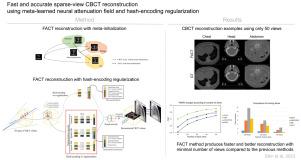基于元学习神经衰减场和哈希编码正则化的稀疏视图CBCT重建
IF 6.3
2区 医学
Q1 BIOLOGY
引用次数: 0
摘要
锥形束计算机断层扫描(CBCT)是一种新兴的医学成像技术,用于可视化患者的内部解剖结构。在CBCT扫描过程中,几个不同角度或视角的投影图像被共同用于重建断层图像。然而,由于病态逆问题的性质,在保持重建图像质量的同时减少CBCT扫描中的投影数量是具有挑战性的。近年来,采用神经辐射场算法的神经衰减场(neural attenuation field, NAF)方法作为CBCT重建的一种新方法被提出,该方法仅使用50个视图即可获得快速而有希望的结果。然而,减少投影的数量仍然是可取的,以减少潜在的辐射暴露,并且考虑到典型的扫描时间,需要更快的重建时间。在这项工作中,我们提出了一种快速准确的稀疏视图CBCT重建(FACT)方法,以提供更好的重建质量和更快的优化速度在最小的视图获取数量(<;50的观点)。在FACT方法中,我们使用少量扫描(= 15)对神经网络和哈希编码器进行元训练,并使用新的正则化技术来重建解剖结构的细节。总之,我们已经证明FACT方法比其他基于不同身体部位(胸部、头部和腹部)和CT供应商(Siemens、Phillips和GE)的CBCT扫描的传统算法产生更好、更快的重建结果。本文章由计算机程序翻译,如有差异,请以英文原文为准。

Sparse-view CBCT reconstruction using meta-learned neural attenuation field and hash-encoding regularization
Cone beam computed tomography (CBCT) is an emerging medical imaging technique to visualize the internal anatomical structures of patients. During a CBCT scan, several projection images of different angles or views are collectively utilized to reconstruct a tomographic image. However, reducing the number of projections in a CBCT scan while preserving the quality of a reconstructed image is challenging due to the nature of an ill-posed inverse problem. Recently, a neural attenuation field (NAF) method was proposed by adopting a neural radiance field algorithm as a new way for CBCT reconstruction, demonstrating fast and promising results using only 50 views. However, decreasing the number of projections is still preferable to reduce potential radiation exposure, and a faster reconstruction time is required considering a typical scan time. In this work, we propose a fast and accurate sparse-view CBCT reconstruction (FACT) method to provide better reconstruction quality and faster optimization speed in the minimal number of view acquisitions ( 50 views). In the FACT method, we meta-trained a neural network and a hash-encoder using a few scans (= 15), and a new regularization technique is utilized to reconstruct the details of an anatomical structure. In conclusion, we have shown that the FACT method produced better, and faster reconstruction results over the other conventional algorithms based on CBCT scans of different body parts (chest, head, and abdomen) and CT vendors (Siemens, Phillips, and GE).
求助全文
通过发布文献求助,成功后即可免费获取论文全文。
去求助
来源期刊

Computers in biology and medicine
工程技术-工程:生物医学
CiteScore
11.70
自引率
10.40%
发文量
1086
审稿时长
74 days
期刊介绍:
Computers in Biology and Medicine is an international forum for sharing groundbreaking advancements in the use of computers in bioscience and medicine. This journal serves as a medium for communicating essential research, instruction, ideas, and information regarding the rapidly evolving field of computer applications in these domains. By encouraging the exchange of knowledge, we aim to facilitate progress and innovation in the utilization of computers in biology and medicine.
 求助内容:
求助内容: 应助结果提醒方式:
应助结果提醒方式:


